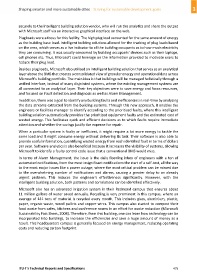Page 489 - Shaping smarter and more sustainable cities - Striving for sustainable development goals
P. 489
securely to the intelligent building solution vendor, who will run the analytics and share the output
with Microsoft staff via an interactive graphical interface on the web.
Plug loads were a focus for this facility. The high plug load accounted for the same amount of energy
as the building base load. Intelligent building solutions allowed for the tracking of plug loads based
on the area, which serves as a live indicator to all the building occupants as to how much electricity
they are consuming. It was usually consumed by building occupants' devices such as their laptops,
cell phones etc. Thus, Microsoft could leverage on the information provided to motivate users to
reduce their plug load.
Besides plug loads, Microsoft also utilized an intelligent building solution that serves as an analytical
layer above the BMS that creates a consolidated view of granular energy and operational data across
Microsoft's building portfolio. The main idea is that buildings will be managed holistically through a
unified interface, instead of many disjointed systems, where the existing management systems are
all connected to an analytical layer. Their key objectives were to save energy and focus resources,
and focused on Fault detection and diagnosis as well as Alarm Management.
In addition, there was a goal to identify any building faults and inefficiencies in real‐time by analyzing
the data streams extracted from the building systems. Through this new approach, it enables the
engineers or facilities manager to identify according to the prioritized faults, where this intelligent
building solution automatically provides the prioritized equipment faults and the estimated cost of
wasted energy. This facilitates quick and efficient decisions as to which faults require immediate
attention and whether the savings justify the expense for repair.
When a particular system is faulty or inefficient, it might require a lot more energy to tackle the
same load and it might consume energy without delivering its task. Their software is also able to
provide useful information, quantifying wasted energy from each identified fault in terms of dollars
per year. Software analytics is also beneficial because it increases the visibility of systems, allowing
Microsoft to identify a faulty control code issue that a conventional BMS would miss.
In terms of Alarm Management, the issue is the daily flooding inbox of engineers with a ton of
automated notifications, from the most insignificant notifications the start of a self‐test, all the way
to the most major issues like a power outage, where the most critical problem can be missed due
to the overwhelming number of notifications and alarms, causing a greater delay to an already
urgent problem. This reduces the engineer's effectiveness significantly. However, with the
intelligent building solution, both patterns and correlations can be identified effectively.
Microsoft also has an advanced irrigation system in their Redmond campus that ensures about
11 million gallons of water saved annually. Recycling is very prominent in this campus, where an
average of 141 tons of material is recycled every month. This includes glass, aluminium, plastic,
paper, organic waste, wood pallets and copper wires. This campus also started to compost their
food waste from cafes, kitchens and conference rooms in an effort for waste reduction (Microsoft
Sustainability Fact Sheet, 2008). Therefore, from this building, one can learn how technology can be
incorporated into buildings, to increase the efficiencies and save a huge amount of money as a
result. This headquarters campus is generally focused on energy management, reducing operating
costs and reducing carbon footprint.
ITU‐T's Technical Reports and Specifications 479

